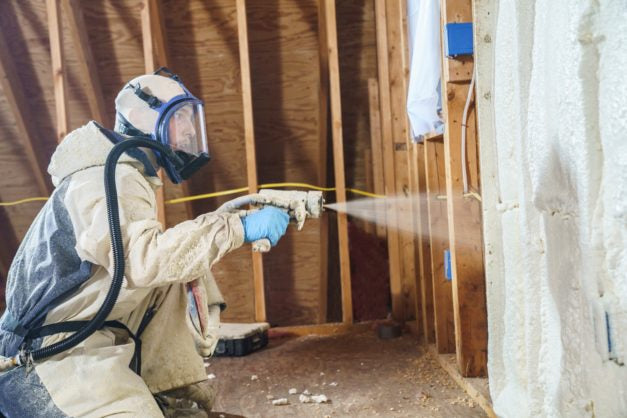Do It Yourself Closed Cell Spray Foam - Easy DIY Guide
Are you dealing with high energy bills and drafts at home? VB Insulation's closed-cell spray foam kits could be your saving grace. They are a simple solution to make your home more energy-efficient.

VB Insulation is a leading name in the spray foam world. For years, they've supplied top-notch kits and supplies to homeowners and contractors. Their closed-cell spray foam has an R-value of 6.89 per inch. This is very high, outperforming fiberglass by a lot.
What makes VB Insulation's kits special is how easy they are to use. You'll achieve professional results on your first try. They come with clear instructions, free support, and how-to videos. VB Insulation even offers a 100% defect-free guarantee, so you can trust what you're using.
This Vega Bond V600 foam is also kind to the environment. It doesn't contain harmful substances like CFCs and Formaldehyde. This helps it act as a barrier against vapor, cutting air, and heat escape. As a result, you can lower your heating and cooling costs significantly.
Ven you're ready to make your home more energy-efficient, look no further. VB Insulation's spray foam kits are perfect for this purpose. They're easy to use and last a long time. Say hello to a warm, draft-free home with ease!
Key Takeaways
- VB Insulation's closed-cell spray foam has one of the highest R-values in the industry at 6.89 per inch.
- Their DIY kits are designed for easy, user-friendly application with comprehensive support and a 100% guarantee.
- Closed-cell spray foam acts as an effective vapor barrier, preventing air leaks and heat transfer to reduce energy costs.
- VB Insulation's closed-cell foam is eco-friendly and contains no harmful chemicals.
- Closed-cell spray foam can significantly improve a home's energy efficiency and thermal resistance.
Introduction to DIY Closed Cell Spray Foam
Vega Bond V600 and Vega Bond V200 kits are great for making your home more comfortable and energy-saving. They use a modern method that's easy to handle. This is different from the old-school foam in a can you might have seen.
What is a DIY Spray Foam Insulation Kit?
A DIY kit includes two parts that mix to make foam. These kits are perfect for smaller projects, covering up to 400 square feet. They're designed so that anyone can use them. This makes insulating parts of your home, like a shed or roof, simple.
Benefits of Closed Cell Spray Foam Insulation
Most kits use closed-cell foam, which is great for insulation. It beats fiberglass in keeping your home cozy. It also keeps moisture out, reducing the chance of mold. Closed cell foam works well both inside and outside your home.
Using spray foam can cut down on how much you spend on energy. This is because it seals your home tight, keeping the heat where it belongs. It's very good at blocking heat flow, which means it's saving you money.
Thinking of fixing up your house or making it more efficient? VB Insulation's DIY foam kits are a smart choice. They're easy to use and work well.
Do It Yourself Closed Cell Spray Foam
Vega Bond V600 insulation is a top choice for sealing spaces. It works as a strong vapor barrier, stopping air leakage and heat loss. For businesses and homes, spray foam beats traditional insulation with better air sealing and R-value. It quickly pays for itself through lower energy bills. With a DIY kit, you get everything to start insulating, saving you money once it's on and dried.
An option like VB Insulation's Vega Bond Purplecoat foam is great for home projects or upgrades. It seals tight, cutting out air leaks and boosting energy efficiency. Whether for better soundproofing or improved insulation, their closed-cell foam is flexible and dependable.
Determining Insulation Needs
Finding the right thickness for DIY closed-cell spray foam is key. This is for the best energy saving and performance. It depends on the climate, where you're insulating, and if you'll use air-conditioning.
How Many Inches of Foam Should I Spray?
If your space will be air-conditioned, VB Insulation suggests: inches in walls (R13) and 3 inches in roofs (R20). For spaces without AC, a 1-inch layer (R6.5) can reduce heat transfer.
Calculating Board Feet for DIY Kits
Know how many spray foam kits to get by multiplying the area by thickness. Typically, DIY kits offer from 200 to 1200 board feet. Choose smaller 200-board-foot kits for easier handling in solo projects. It's smart to get a little extra to cover waste, uneven spray, and any unforeseen problems.

Personal Protective Equipment (PPE)
Spray foam projects need proper PPE for safety.6 This includes masks, eye protection, and gloves.
Proper Gear for Spraying Foam
The right PPE for spraying foam includes a Tyvek suit and a respirator. It also needs gloves and shoes to keep chemicals off you.
Because spray foam is hard to get off, PPE is vital. It protects you from the foam and its fumes.
Different SPF chemicals require special PPE. A supplier can tell you the safe times to re-enter after spraying.
Clothing like coveralls and special boots are crucial. Gloves help against certain materials. Eye and breathing protection are also needed.
Choosing the right respirator depends on where you're working. Checking PPE before starting is very important.
Project Preparation
Starting a DIY closed-cell spray foam insulation project means you need to get ready right. Making sure the area is clean and covered stops the spray from going everywhere. You cover windows, floors, and more with thick plastic, holding it down with tape, glue, or staples.
Protecting Areas from Overspray
Covering and sealing off where you’ll work is very important. This keeps the spray foam off places you don’t want it. Since spray foam is messy, it’s hard to clean if it gets on other things. So, containing the area well saves you trouble later.
Ventilation Requirements
Good ventilation is a must for a safe DIY spray foam job. The fumes can be harmful, so it's best to let them out. Open windows, and doors, and use fans to make sure the air moves and takes the fumes away.
Substrate Conditions for Spraying
Before you spray foam, the surface needs prep. It has to be dry and stable. Things like plywood or drywall work. Also, it should be not too cold, at least 65°F. The best temperatures are between 75 and 100°F for the foam to stick well.

Application Tips-Maximizing Yield from Kits
To get the most out of your spray foam kits, warm up the components to 75-100°F. Shake them hard for 1-2 minutes. This warming and shaking will mix the chemicals well.
Spraying Technique
When you start to spray, first create a border around the area you're filling. Spray a 1/2-inch layer along the edges. This tactic helps the foam spread better without bulging.
Work in layers, adding foam in 2-inch parts, and then let it sit for a bit to solidify. Don't make the layers thicker than 2 inches.
Combining Foam with Fiberglass Insulation
You can mix spray foam with fiberglass in a method called "flash and batt". Begin by sealing with a thin layer of foam. Then, use fiberglass to fill the rest.
This combo is cost-effective and offers dual benefits. It lets you keep the air-sealing advantages of foam. At the same time, you use less foam. For 2x4 wall spaces, spray just under 2 inches of foam and add fiberglass to reach an R-17.3 insulation value.
Conclusion
VB Insulation Foam's closed-cell spray foam kits are a great DIY solution. They help insulate, seal air, and protect homes. Their foam has a high R-value, which means better energy efficiency and lower bills.
These kits are easy for anyone to use. They come with all you need for a successful install. So, if you want to make your home more efficient or do a project, Tiger Foam's spray foam is a top choice.
VB Insulation is also a top choice for DIY spray foam. Their kits are good for saving money, improving comfort, controlling moisture, and reducing noise.
When picking a foam, look at the R-value and your project's needs. Using these foams right can save you big and help the planet.
FAQ
What are the key benefits of using closed-cell spray foam insulation?
Closed cell spray foam seals spaces well, keeping air and heat from passing through. It's much better at insulating, sealing, and resisting moisture than fiberglass. By using it, your place stays comfortable while saving on energy bills.
How do I determine the right amount of spray foam insulation needed for my project?
The ideal thickness of foam depends on where you live, the area you're insulating, and the use of air conditioning. For AC areas, aim for 2 inches thick on walls and 3 inches on roofs. To figure out how many kits you need, calculate the needed square footage times the thickness. Most DIY kits cover 200 to 1200 board feet.
What personal protective equipment (PPE) is necessary when applying spray foam insulation?
You need the right gear to avoid breathing in chemicals and keep the foam off you. Wear a chemical-resistant suit with a hood, a mask with P100 filters, and good gloves. You also need to cover your shoes or use disposable booties.
How do I properly prepare the area for spraying closed-cell foam insulation?
Start by clearing the space and protecting nearby items with thick plastic. Make sure you have good ventilation to draw out fumes. The work surface should be dry and sturdy for the foam to stick properly.
What are some tips for applying closed-cell spray foam insulation?
Heat the foam kit parts before use and shake them well. When spraying, begin by outlining the area to catch missed spots. Apply foam in layers, pausing to let each one set. You can also use it with fiberglass for extra insulation.




